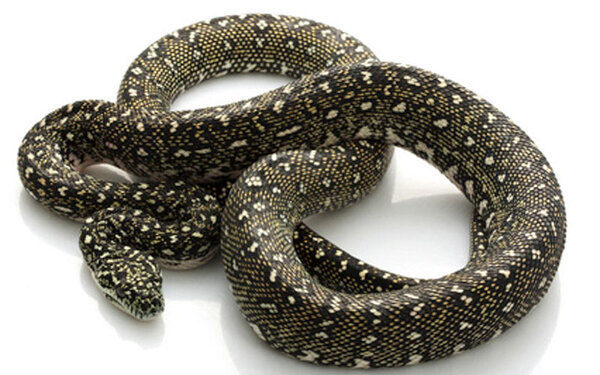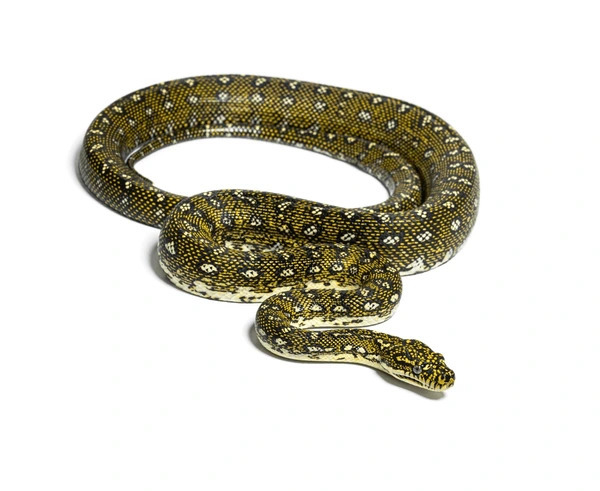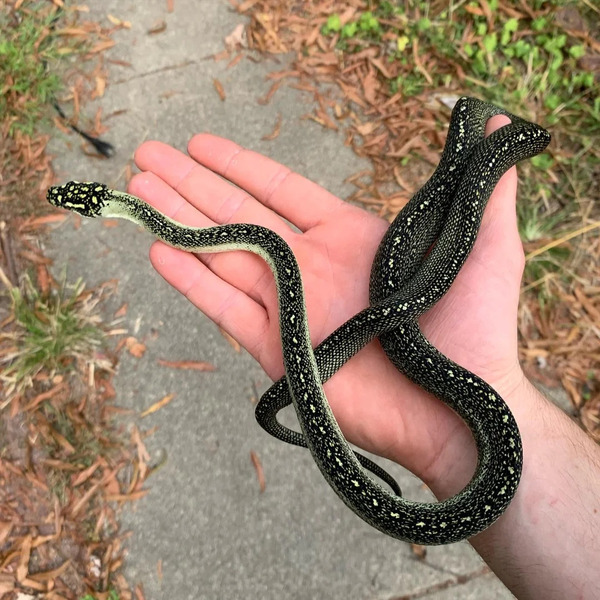The Diamond Python (Morelia spilota), also known as the Jungle Carpet Python, is a stunning snake native to eastern Australia. This species is known for its striking black-and-yellow or black-and-white coloration, which resembles a diamond pattern. In this article, we’ll explore everything you need to know about the Diamond Python, from its appearance and behavior to its habitat, diet, and care requirements.
Whether you’re an aspiring snake owner or simply fascinated by reptiles, this guide will provide you with the essential information to understand the Diamond Python better.

The Diamond Python is a non-venomous constrictor, meaning it kills its prey by wrapping around it and squeezing until the animal suffocates. Unlike many venomous snakes, the Diamond Python uses its strength rather than venom to catch and kill its prey.
Scientific Name: Morelia spilota
Common Names: Diamond Python, Jungle Carpet Python
Family: Pythonidae
Native Habitat: Eastern Australia, particularly in the rainforests and woodlands of New South Wales and Queensland.
Diamond Pythons are known for their beautiful, vibrant patterns. Their scales are glossy and smooth, creating an iridescent shine. They can vary in color but are generally characterized by:
Body Color: Primarily black with yellow or white markings.
Pattern: A "diamond" or "chain-link" pattern that is unique to each individual.
Size: Adult Diamond Pythons typically grow to between 6 to 10 feet (1.8 to 3 meters), although some can reach up to 12 feet (3.7 meters).
Head: Relatively small and triangular, with distinctive dark markings around the eyes.

Diamond Pythons are generally known for their calm temperament, making them a popular choice for experienced reptile keepers. They are mostly arboreal (tree-dwelling) but will also spend time on the ground.
Activity: They are primarily nocturnal (active at night) but can also be seen during the day in cooler weather.
Temperament: These pythons are not aggressive and are known for being relatively docile, especially when raised in captivity.
Defensive Behavior: If threatened, they may strike, but they rarely show aggression unless provoked.
Diamond Pythons are native to the rainforests and woodlands of eastern Australia. They are arboreal, meaning they spend a lot of their time in trees, but they also live on the forest floor.
Preferred Habitat: Moist, humid environments like rainforests, woodlands, and scrublands.
Geographical Range: Found in New South Wales and Queensland, particularly in areas with dense vegetation and tree cover.
As constrictors, Diamond Pythons hunt by ambushing their prey. They primarily feed on small mammals, birds, and reptiles, though they are capable of eating larger prey, including possums and small kangaroos.
Feeding Style: Ambush predator. They use their camouflage to blend into their environment and wait for unsuspecting prey to approach.
Diet in Captivity: In captivity, they are typically fed rats, mice, and small rabbits. They may eat every 1 to 2 weeks, depending on their size and age.
The Diamond Python is oviparous, meaning it lays eggs. During the breeding season, males will compete for females, often engaging in combat.
Breeding Season: Typically occurs in the winter months (June to August in the southern hemisphere).
Eggs: Females lay between 10 and 30 eggs, which they incubate for around 2 months before they hatch.

While the Diamond Python shares similarities with other pythons, it has distinct features that set it apart. Let’s compare the Diamond Python with other popular pythons, such as the Ball Python and the Reticulated Python.
| Feature | Diamond Python | Ball Python | Reticulated Python |
|---|---|---|---|
| Scientific Name | Morelia spilota | Python regius | Python reticulatus |
| Size | 6-10 feet (up to 12 feet) | 3-5 feet | 10-20 feet (can exceed 30 feet) |
| Color and Pattern | Black with yellow/white "diamond" patterns | Typically dark brown with light yellow or gold patterns | Dark brown with intricate geometric patterns |
| Temperament | Docile, calm (with handling) | Calm, gentle (great for beginners) | Can be aggressive, requires experienced handlers |
| Native Habitat | Eastern Australia (rainforests, woodlands) | Sub-Saharan Africa | Southeast Asia (rainforests, grasslands) |
| Diet | Small mammals, birds, reptiles | Small mammals, birds | Large mammals, birds, even livestock |
| Lifespan | 20-30 years in captivity | 20-30 years in captivity | 15-25 years in captivity |
While Diamond Pythons are relatively easy to care for compared to some other species, they still require a proper setup and attention to their needs.
Enclosure: A large, secure enclosure with plenty of climbing opportunities is necessary, as Diamond Pythons are arboreal.
Size: At least 6 feet long for adults, with branches and hides for comfort.
Temperature: They need a temperature gradient with a basking spot of 90-95°F (32-35°C) and a cooler area around 75°F (24°C).
Humidity: The enclosure should be kept humid, ideally around 50-60%. Regular misting and a water dish will help maintain moisture.
Feeding: In captivity, feed your Diamond Python rats or mice. Juveniles may eat smaller prey, while adults require larger meals.
Like all snakes, Diamond Pythons can suffer from certain health issues. Common problems include:
Respiratory Infections: Typically caused by improper temperature or humidity.
Mites: These external parasites can be a problem if the enclosure is not properly cleaned.
Obesity: Overfeeding can lead to obesity, which is dangerous for a python's long-term health.
The Diamond Python is an elegant, non-venomous constrictor that is admired by reptile enthusiasts for its stunning appearance and relatively docile nature. Native to eastern Australia, it thrives in humid, forested environments and preys on small mammals, birds, and reptiles. With the proper care, a Diamond Python can live for many years, making it a rewarding pet for experienced snake owners.
Whether you’re considering adding a Diamond Python to your collection or simply intrigued by this beautiful species, understanding its care requirements and behavior is key to ensuring it lives a long, healthy life.
Remember to always research thoroughly and, if you plan to keep one as a pet, make sure you're prepared for its specific needs.

Diamond Python Syndrome (DPS) is a term used to describe a range of health issues that can affect the Diamond Python (Morelia spilota), although it is not a formally recognized disease in scientific literature. This syndrome is typically used by reptile enthusiasts and breeders to refer to a collection of symptoms that may arise in Diamond Pythons due to improper care, environmental factors, or genetic predispositions. DPS is more commonly observed in captivity than in the wild, as it is often linked to husbandry practices, such as diet, humidity, temperature regulation, and stress.
While Diamond Python Syndrome is not a specific disease, it encompasses various symptoms, which may include:
Respiratory Issues: Diamond Pythons are susceptible to respiratory infections, which can manifest as wheezing, labored breathing, or mucus discharge from the nose. These infections are often caused by inadequate temperature and humidity in their enclosure.
Skin Shedding Problems: Inadequate humidity or a lack of proper shedding aids may lead to retained shed skin, particularly around the eyes or tail. This can cause discomfort and even infection if not properly managed.
Weight Loss or Poor Feeding Response: If the snake is underfed or stressed, it may refuse food or lose weight. This is often seen in snakes that are kept in stressful environments or that are not fed appropriate prey.
Abnormal Behavior: Stress or improper care can lead to abnormal behaviors, such as aggression or excessive hiding. This behavior can often be tied to poor environmental conditions.
Swelling or Bloating: In some cases, Diamond Pythons may exhibit bloating, which could be related to an internal infection, improper digestion, or parasites.
Lethargy: A Diamond Python suffering from DPS may become unusually lethargic, spending long periods of time inactive. This is often due to stress, poor diet, or an inappropriate temperature gradient in the enclosure.
Several factors can contribute to the development of DPS, and they are typically related to poor husbandry or external stressors:
Improper Temperature and Humidity: Diamond Pythons are native to humid rainforests and woodlands, so they require a carefully controlled environment with the right humidity (50-60%) and temperature gradient (warm basking spot of 90-95°F and cooler areas of around 75°F). Incorrect temperature and humidity levels are a leading cause of health problems.
Poor Diet: A lack of variety in diet or feeding inappropriate prey can weaken the immune system of the snake, making it more prone to infections and other health issues. In captivity, Diamond Pythons should primarily eat rodents or birds.
Stress: Stress is a significant factor in many cases of DPS. Stress may be caused by overcrowding in enclosures, frequent handling, inadequate hiding spots, or a noisy environment. Stress weakens the snake’s immune system, making it more susceptible to infections.
Inadequate Enclosure Size: A cramped enclosure with insufficient climbing branches or space to roam can lead to stress and physical health issues in Diamond Pythons. These snakes are arboreal, so they need space to climb and explore.
Genetic Factors: Some Diamond Pythons may have genetic predispositions that make them more susceptible to certain health issues, though this is less common.
To prevent DPS and ensure a healthy Diamond Python, owners should adhere to the following guidelines:
Maintain Proper Temperature and Humidity: Ensure the enclosure has a proper temperature gradient and maintain humidity levels around 50-60%. Regularly check the temperature with a reliable thermometer and humidity with a hygrometer.
Provide a Balanced Diet: Feed your Diamond Python a varied diet of appropriately sized rodents (mice, rats) or birds. Avoid overfeeding, and make sure that prey items are appropriately sized to prevent obesity or digestive issues.
Stress Reduction: Minimize stress by providing a quiet, secure environment. Offer plenty of hiding spots, climbing branches, and avoid frequent handling, especially during feeding times or when the snake is adjusting to a new environment.
Regular Health Checks: Monitor your snake for signs of illness, such as lethargy, abnormal behavior, respiratory distress, or skin shedding problems. If you suspect a problem, consult a reptile veterinarian for advice and treatment.
Proper Shedding Aids: Ensure that your snake has access to adequate humidity to aid in shedding. You can also offer a shedding box (a humid hide) where the snake can rub against the rough surface to help remove old skin.
Provide a Large Enclosure: A spacious enclosure is crucial for Diamond Pythons, as they are semi-arboreal and need room to climb and stretch. The enclosure should be at least 6 feet long for an adult python and contain branches, hides, and proper heating.
Diamond Python Syndrome, while not a formal disease, is a term used to describe a range of health issues caused by improper care and environmental stress. It can manifest in various symptoms such as respiratory issues, poor feeding responses, abnormal behavior, and lethargy. Proper husbandry, including maintaining the right temperature, humidity, and diet, is essential to prevent these problems. Diamond Python owners should strive to create a stress-free environment to ensure the health and well-being of their pets.
animal tags: Diamond-Python
We created this article in conjunction with AI technology, then made sure it was fact-checked and edited by a Animals Top editor.